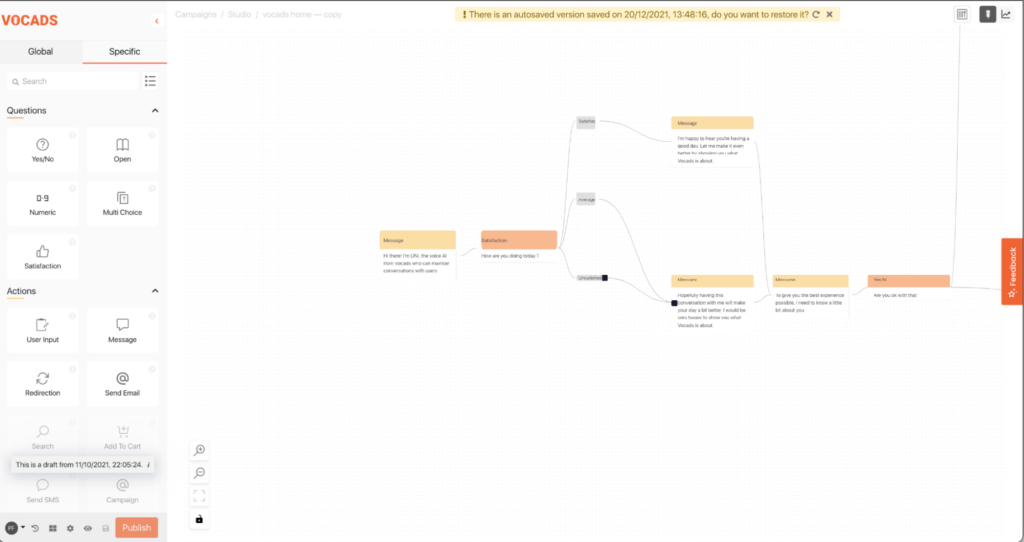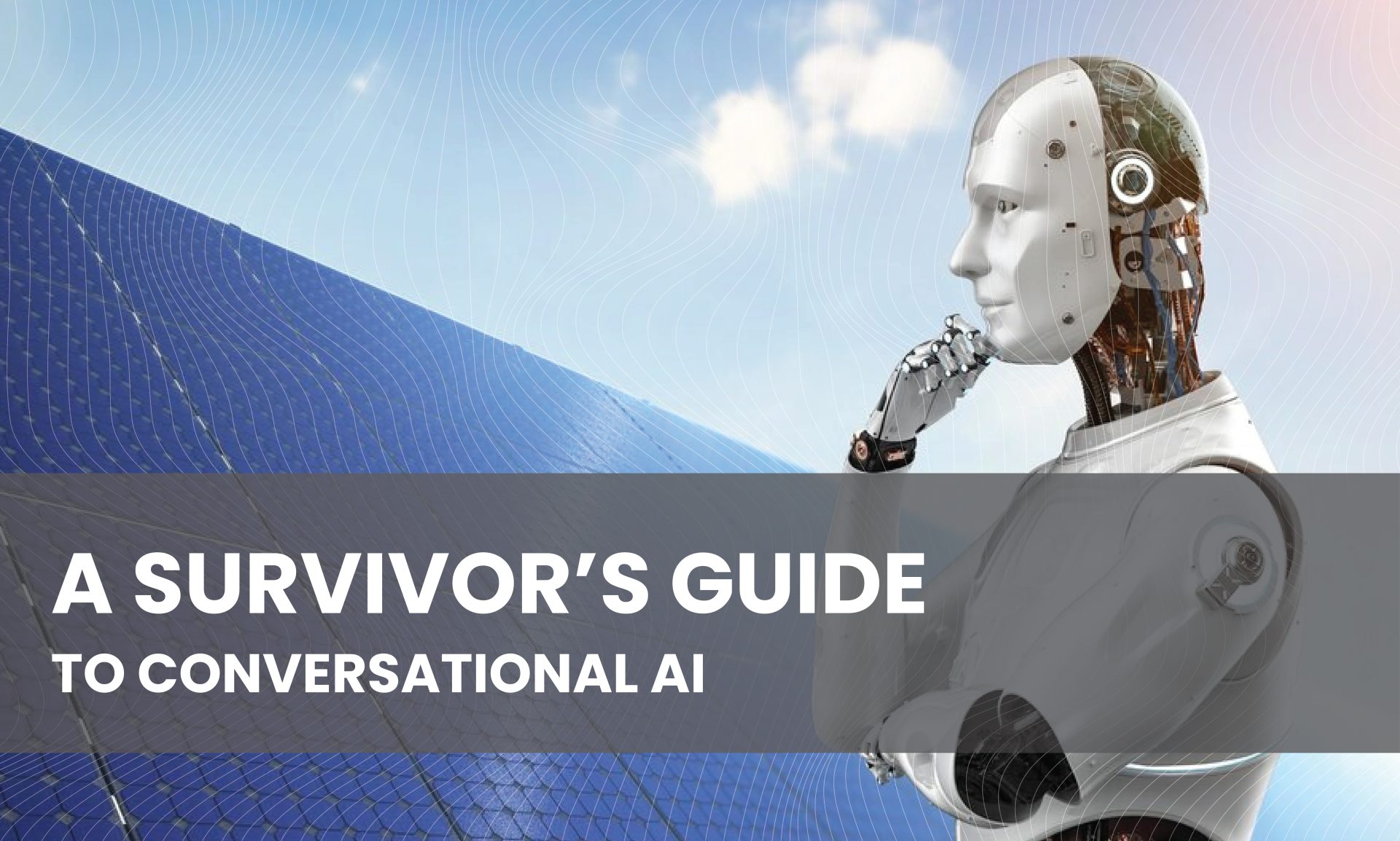Introduction
Welcome to our survivor’s guide on conversational AI (Artificial Intelligence).
This topic is extremely wide and wild so get your map and compass out!
First and foremost, why is conversational AI important?
Conversational AI is at the core of many technologies used everywhere today such as chatbots, voice bots and voice assistants. Without conversational AI, those technologies would not work nearly as well as they do today.
In this post, we will cover:
-
- What conversational AI is
-
- The benefits of conversational AI
-
- Where it is being used
-
- How to get started with conversational AI
By the end of this post, you should have all the basic knowledge to understand what conversational AI is, how it works and how it can help you.
Ready? Grab your spear and let’s dive in!


What is conversational AI?
Conversational artificial intelligence (AI) is a family of algorithms that uses machine learning to understand, process and answer user input (usually speaking or typing).
Conversational AI mainly borrows algorithms from Natural Language Processing (NLP), NLU (Natural Language Understanding) and NLG (Natural Language Generation) like sentence classification, named entity recognition or sentence generation to analyse and maintain a conversation.
In this type of AI, it’s all about text: the machine gets text as input, processes it, and sends some output text back to the user.
In terms of technology, the easiest and most reliable way to get a text from a user is to ask them to type it with a keyboard (chatbots).
I can hear you think: “But I can also have oral conversations with AIs, right ?”
Yes, of course.
Even when working with audio (getting speech in and sending speech back), the input audio signal will be turned into text with a speech-to-text module, this text will be processed as usual text, a text response will be generated and the output audio is generated with ……. a text-to-speech module!
The figure below shows a very simple sketch of how conversational AI works


In the end, it’s just about having text in and text comes out. Easy isn’t it?
By repeating this process, again and again, a conversation between the user and the AI engine unfolds. That’s conversational AI in a nutshell 🙂
How does conversational AI work?
In the previous section, we covered what conversational AI is and how different types of inputs can be turned into text for AI.
You may now want to tell me: “I got that, but how does the AI process text? How does it generate an answer from a query?”.
This is a really good question and where the meat of conversational AI stands.
While it would take me several hours (if not days) to explain to you all the ins and outs of conversational AI engines, I will try to convey to you the principles behind the essential core components of those systems in just a few minutes.


A conversational AI engine usually relies on 3 key components:
Input preprocessing
This step transforms the input text to make it easy for complex algorithms to work with.
In machine learning jargon, pre-processing refers to all the transformations done to the input data before giving it to the actual AI model.
When working with images, pre-processing can include putting them in grayscale, adjusting the resolution or rotating them. When working with text, some of the most common NLP pre-processing actions are:
-
- Removing punctuation
-
- Removing stop words (a, the, this, that, …)
-
- Casting to lower cases (for example “I saw Will Smith on the BBC.” becomes “i saw will smith on the bbc.”)
-
- Lemmatization or bringing every word to its root form (for example best, better, or great all become good)
-
- And more!
For example, pre-processing a sentence like “Yesterday, I saw Will Smith on the BBC.” could become “Yesterday I see will smith on BBC”.
In the end, this is just about cleaning up the input text and putting it in a standardized format that will make things easy for the AI to work with.
Processed input analysis
While the previous step consisted of fairly basic algorithms, this is where the magic happens.
Here, inputs come in in a well-formatted format, ready to be digested by whichever AI we have in place.
The brain behind this part is Natural Language Understanding (NLU) and recent advances in machine learning have made this brain more powerful than ever.
For clarity, machine learning is a subfield of artificial intelligence where models learn to solve tasks from a set of example data. Deep learning is a subset of machine learning where models are deep neural networks (hence “deep” learning).
Here’s a drawing of the hierarchy between these disciplines:


The most advanced methods of NLP currently use machine learning and deep learning to provide outstanding performances on tasks like language representation, sentiment analysis or even translation.
As a side note for the historians out there, before deep learning, NLP and NLU techniques went from linguistics to computational linguistics to statistical natural language processing. A whole legacy of scientists standing on the shoulders of giants led to the techniques used today and will lead to even better solutions tomorrow.
Coming back to the ground, you might say; “Those things are nice, but how does the analysis of the processed inputs actually work?”
Well, it all depends on the use case.
In this step, algorithms can extract many pieces of information, from specific details (like a product name or order quantity) to more advanced concepts like the user’s intent or sentiment.
As I said above, I could write a lot about how those models work in detail, but this post is not the appropriate space for it.
If you would like to know more details about how things work here, I highly recommend looking at more specialized sources like Towards Data Science’s excellent post on sentiment analysis.
If you’re really serious about this and want to put the time and effort in, check out Deeplearning.AI’s Coursera specialisation in NLP.
Answer generation
Ok, so, we had our text input, which we pre-processed to make it easy to analyze and the AI has extracted information from it.
Now that we have extracted valuable information from the input, it’s time to generate an actual text answer for the user.
This is the realm of NLG (Natural Language Generation) and, once again, deep learning-based methods are at the top of the game.
In this phase, neural network models take as input the information extracted in the previous steps, and generate an appropriate text answer.
This happens in two steps.
First, the system decides in which direction the conversation should be led using methods like reinforcement learning.
Then, the model generates appropriate text to be served as an answer to the user.
If the user is having an oral conversation with the AI, this text is converted to audio by a text-to-speech module. Otherwise, it’s simply displayed on the screen.
Once again, if you want to understand what happens here in greater detail, I highly recommend you have a look at more specialized blog posts or online courses in AI and NLP.
And this is it really!
The whole conversational AI cycle is about getting some text in, cleaning it up, extracting meaningful information from it, deciding on where to lead the conversation and generating a text answer accordingly, eventually turning it into speech if the user is having an oral conversation with the system.
By repeating this loop, and smartly orientating the flow, the AI can hold conversations with users!
If you’re still with me now, congratulations, you’ve just finished the technical bit!
Now, let’s go into lighter territories and keep learning more about how conversational AI is used and why it’s so great.
Chatbots VS conversational AI
If you’ve already read some posts about conversational AI and chatbots, you will have seen those 2 terms being used on and on again.
This may have led to confusion: “What is the difference between chatbots and conversational AI?”.


While some people show them as two different things, conversational AI is actually the brain behind chatbots.
The term “chatbot” suffers a bit from its origin, as first chatbots used old technologies not relying on machine learning and were, let’s face it, pretty stupid.
They would only answer a small set of questions with predefined answers, not the best user experience.
But now, the brain behind chatbots and user assistants has levelled up thanks to the power of conversational AI.
So, those are not terms to be opposed really. Chatbots are one way to interface users with a conversational AI, the same way voice assistants are.
Now that we’re clear on the vocabulary, I know you’re looking forward to knowing where conversational AI is used.
As your host, I am at your commands, let’s dive into use cases!
Conversational AI use cases
As we’ve seen above, conversational AI is the brain that powers all chatbots and voice assistants.
Therefore, everywhere a chatbot or voice assistant is in place, conversational AI is being used!
I’m sure that you’ve already come across those things but I will still outline a few examples to give you some ideas on how conversational AI can help you.


First, conversational AI has a lot of customer-centric applications:
-
- Onboard visitors on your website
-
- Help prospects find their ideal product
-
- Turn an entire sales funnel into a chatbot or a vocal conversation
-
- Answer specific FAQs
-
- Teach users on e-learning platforms
These are where you can find chatbots or voice assistants powered by conversational AI to improve your customer’s life.
Conversational AI is also being found a lot in business-centric applications:
-
- Task automation
-
- Improvement of call centre management at a reduced cost
Conversational AI has a lot to bring to organizations: from powerful task automation to better customer service while reducing the load on employees and lowering costs.
Isn’t that amazing?
Moreover, given how general this technology is, it is being used in a lot, I mean A LOT of different areas:
-
- Retail
-
- Banking
-
- Healthcare
-
- Travel
-
- Real estate
-
- Restauration
-
- Marketing
-
- And much much more!
Conversational AI has basically spread across all domains of applications now, and you can seize this opportunity to bring this amazing technology to your field!
This technology is a formidable opportunity.
If, at this point, you see all the conversational AIs around you, and would like to add some to whatever you’re doing, but aren’t sure how to set this up, don’t worry: the next section has you covered.
4 steps to implement conversational AI
While this may sound challenging at first, improving your activity with conversational AI is not that difficult.
It just takes a little bit of planning and craft.
Understand your business and decide on what you want to improve
Before you jump into any kind of technology or software, it’s essential to come back to the basics.
Conversational AI will help you solve a problem, therefore you should first properly define the business problem that you want to solve.
Let’s imagine that you are selling products online: sales are on a high level and are on the rising edge.
Despite having a great quality product and a very small proportion of your users complaining about it, this small proportion starts to represent quite a few people when you sell a lot.
You then realize that you are the victim of your success: you are not able to provide the same quality customer service as a few weeks ago because there are too many enquiries.
You feel overwhelmed with customer complaints.
And in the meantime, you wonder: “It would be so great to have something that automatically answers customer enquiries and actually smarter than the FAQ section of my website …”


THIS is the particular problem you will want to solve with conversational AI.
You see, it’s all about looking at the structure of your activity, finding the bottlenecks and then thinking if conversational AI can help with that.
Determine the channels that best suit your needs
You’ve identified what conversational AI will help you with, now let’s think about how it will do so.
The first question is: “On which channel (oral or written) should the conversation take place?”.
If the answer to that is written, go for a chatbot.
If on the other side it’s oral, go for a voice assistant.
Picking the right channel of communication is key to successfully implementing conversational AI into a business.
Depending on the context, people may prefer speaking or writing. Similarly, they may prefer to have answers being told to them orally or written on the screen.
Seeking expertise
You now know which exact problem you want to tackle and which form the conversational AI should take, it’s not time to design the whole system!
Just like anything, there are great and less great conversational AI designs. To have a smooth user experience, it’s not just about putting a dialogue together, it takes careful thought and planning.
Designing a perfect conversational AI application for your use case requires skills in marketing, copywriting and at least an understanding of machine learning.
If this looks scary to you, and you don’t feel like you have those skills, don’t worry.
There are companies and agencies around that can help you in the process. To learn more, check our post on the top voice agencies


If you would rather learn those skills yourself, I highly recommend having a look at other posts on this blog like our tour of voice technology or our definitive quide on voice marketing.


There are so many ways to get started with conversational AI today, you can even learn those skills while crafting if you don’t mind iterating more and starting with a suboptimal product.
In the end, creating a conversational AI solution is a true skill. To benefit from this skill, you can either ask someone else to do it for you, take the time to read about it or learn by practising and actually doing it.
Depending on your situation, you may prefer one or the other solution.
The choice is yours really!
Craft the actual thing
Now you’ve identified a specific problem to solve with conversational AI, which forms it will take and how you will find or learn the expertise, it’s time to start crafting!


I’m a mentalist, I can hear you screaming in your head: “This requires skills in marketing, copywriting, and understanding of machine learning and NOW I also have to be able to CODE ?!”
Wait wait wait wait wait, Don’t quit just yet!
While this was still true a few years ago, technology has now made a lot of progress and creating a chatbot or voice assistant does not require coding anymore.
With a rise in no-code solutions, you can now design entire end-to-end conversational AI workflows in simple drag-and-drop interfaces.


The requirement to code belongs to the past.
Embrace the future and adopt no-code solutions like Vocads for easier, faster and more flexible development!
Conclusion
I hope you enjoyed this article on conversational AI.
This is a super-wide topic and I hope that you’ve now got all the essentials to understand what conversational AI is, how it works, why it is important and how to set one up.
Now I want to hear from YOU!
How often do you interact with conversational AI systems? What’s the most original application of conversational AI you’ve ever seen?
And, most importantly, how was your experience with those systems?
Share your opinion in the comments down below or by tagging us on social media!
If you know someone interested in this type of topic, send them a link to this post.
If you’ve appreciated our work, the best you could do to spread the word would be to share this article on your social media!
Thanks for reading, see you soon for a new exciting post on the roaring revolution of voice technologies


